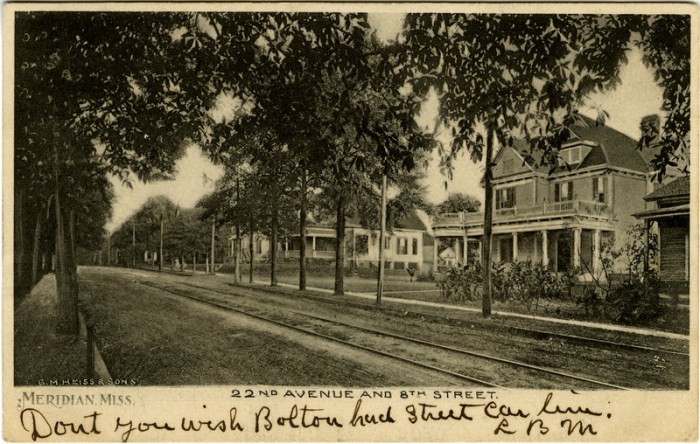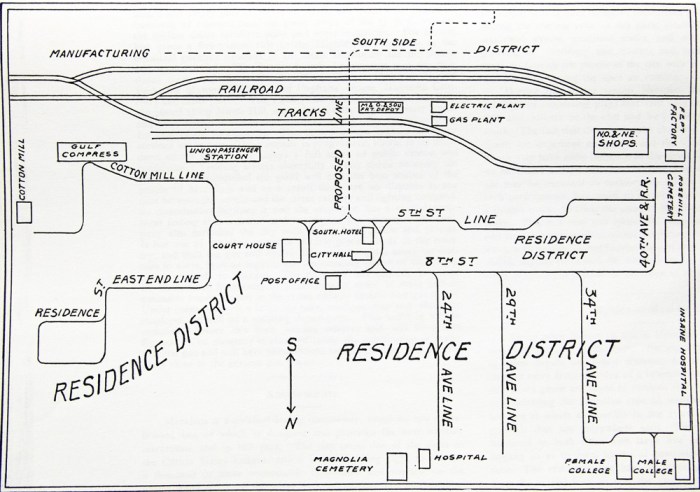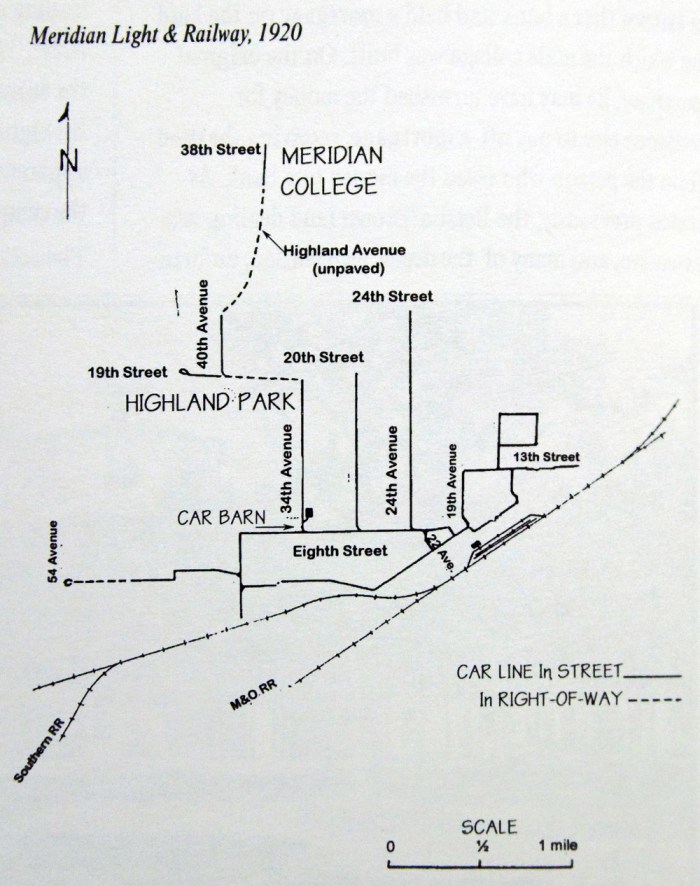Today’s post is Chapter 7 in our series re-printing Frank Brooks’ “Travelling by Trolley in Mississippi: Stories about Streetcars,” originally published in 1983. View other posts in the series at the “Streetcars” tab.
In place of the 1920 streetcar map in the book, drawn by Gordon Powers, I have inserted two original streetcar maps from 1907 and 1920. These were provided by MissPreser Nathan Culpepper. The 1920 maps are identical, but the original map sent by Nathan is more clearly scanned than the drawing by Gordon Powers.
——————————————
Because it has been so long since Meridian had trolleys, my efforts to learn details of that operation have met with very little success. Initial abandonments of the Meridian car lines began as early as 1922 when the Meridian Light and Railway Company took up the tracks of its College line which ran north from Highland Park. The bus service which replaced that trolley line marked the beginning of a trend which would end all streetcar service in favor of busses in September, 1925.
The Meridian Light and Railway Company was incorporated February 22, 1901 as a successor to the Meridian Street Railway and Power Company. At the height of its operations, the M.L. & R. Co. owned 35 cars, 11 of which were trailers placed in use by coupling them onto regular motor cars. Before any abandonments, Meridian’s car lines ran over slightly more than 13 miles of track. I clearly remember about a half block of track still visible alongside the Lamar Hotel during the late 1940s.
My father used to tell a story related to Meridian trolleys which always struck me as being quite humorous. He and his brother, both country lads who lived in Lake, Miss., were in Meridian for a few days during the summer visiting their uncle and his wife. All of the pleasures of the city were at their disposal! One evening their youngish uncle and aunt drove them downtown to attend a movie. The couple gave the boys explicit directions on how to come home by boarding the car signed for route “3” at a particular corner near the theater. Unfortunately, there was a mix-up. The first car to come along happened to be numbered “3,” and that got the boys’ attention to the exclusion of looking more carefully at what route it was traveling.They wound up some distance across town from where their nervous relatives were pacing the floor in alarming wonder as to what might have happened to the boys. To make matters worse, it was the last run of the evening and the car was returning to the barn, and not back downtown. It took some doings by a concerned motorman, who was handy with an available telephone, to get the boys in touch with their relatives who came as quickly as possible to rescue their wards!
When Meridianites voted on a streetcar referendum on July 23, 1925, only 316 citizens voted to retain trolley transportation. Less than six weeks after that vote, busses were already following much the same routes previously covered by the trolleys with the exception of a new business district loop. All busses were routed over that loop to take them past the city’s beautiful new Spanish-mission style Union Railroad Terminal. A new bus line was also established through the southern part of the city where the trolleys never ran. I have been able to locate some photographs showing that most of the Meridian cars were single-truck, “pay within” cars. The Brill Company built the cars which were designed to seat 32 passengers.
————————————————-
ABOUT THE AUTHOR: Frank A. Brooks, Jr. has loved trains and streetcars for as long as he can remember. He and his wife Jo Anne are parents of 2 children and grandparents of 4. During his active ministry of 43 years in the Presbyterian Church he served in Kentucky, Mississippi, Virginia and Arkansas. In retirement, Dr. and Mrs. Brooks live in her hometown Corinth, MS.
Categories: Architectural Research, Books, Meridian




Looking at the maps Nathan was kind enough to share it doesn’t look like the trolly lines ever were able to meet the ambitious expansion plans of 1907.
LikeLike
That’s right (I didn’t catch it at first because of that weird S-N orientation on the 1907 map. I have a friend whose grandparents lived on the south side of the tracks and he said they never got the streetcars there, maybe because it was a mill town neighborhood and possibly considered not a profitable route?
LikeLike
Things to do on a Saturday afternoon in Meridian? Why not try a drive-by of Trolley sites in Meridian??? Not comprehensive, but a few sites corresponding to the 1920 map shown above. Need some help here – is the building identified as the car barn, actually the correct site? It matches the general location of the site shown on the scanned map above:
http://flic.kr/s/aHsjxzfDQa
LikeLike
Thanks for sharing the photos. Those plaques are great.
I bet part if not all of that building is the car barn. Looking at a Bing aerial map the building has a water tower that probably would have been associated with the generation of power for the cars, and a bridge for trolleys, as 34th did not cross that block down to 8th ave. The 1912 Sanborn map confirms that the existing building is roughly the same size of the car barn on that site and that the bridge was a right of way for the trolleys. In the 1906 Sanborn map is shows a narrow building, which is the wall you capture in your photographs.
Very cool! Youve piqued my interest. Thanks again for sharing.
LikeLike
By 1950 the Meridian Light and Railway Co. Car Barn and Repair Shops had been coverted into the Sanson Hoisery Mills Inc. Plant #7
LikeLike
Interesting. I’ll try to see what condition the bridge is in between 8th and 10th Streets…
LikeLike
Looked today, the trolley bridge remains between 8th and 9th streets. Not sure of the condition, however.
LikeLike
According to the US Census Bureau compilation for 1890, Meridian’s horsecar company (which opened service in 1883) had 4.0 miles of line and carried 210,665 passengers.
At 1902, the year after the first electric streetcars ran in Meridian, the company had 5.5 miles of line and carried 565,425 passengers.
At 1907, the company had 10.5 miles of line and carried 2,010,700 passengers.
Thereafter (1912, 1917, 1922, 1927), it was grouped together with “the rest” of Mississippi’s streetcar systems in the Census Bureau surveys. My “best guesses” for annual passenger traffic thereafter:
1912, very roughly 2,100,000.
1917, very roughly 1,800,000.
1922, very roughly 1,700,000.
Dr. Brooks mentioned that the first line converted to buses was the College line, on Highland Avenue, in 1922. That reduced the system length to about 9.1 miles.
(I know there was a “Meridian College” in Meridian around the World War I era, but there is no such institution in northwest Meridian today. Does anyone know what became of the streetcar-era Meridian College?)
LikeLike
I happened to run across this web site and wish to comment. The map depicted herein may not be correct. I lived at 2301 41st Avenue, Meridian for many years and the electric trolley line turned from 41st Avenue directly in front of my house and crossed a branch creek behind 2316 41st Avenue before continuing to what was Electric Avenue, now Highland Avenue, ending at Beeson College. The concrete bridges at still in place in front of my house and behind 2316. The entrance to Beeson College was still in place as late as 1960?. The house at 2301 41st Avenue was built by my great uncle who worked for the trolley company.
LikeLike
Does anyone know where i can find pictures of poplar springs drive prior to 1998? Specifically 3611 poplar springs drive? I’ve checked archives and they have nothing. The house burned in 1998, so any pictures prior to that would be appreciated!
LikeLike